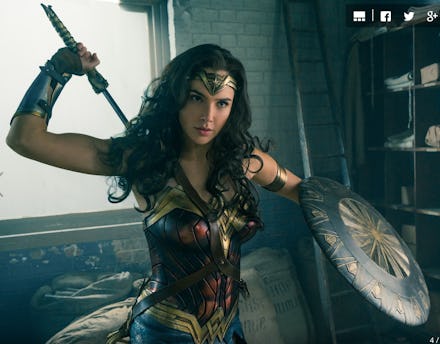This is the surprising reason 'Wonder Woman' was banned in 1942

As the new film adaptation of Wonder Woman starring Gal Gadot hits theaters around the country, the warrior heroine continues to symbolize women's empowerment and activism. But when Princess Diana of the Amazons was introduced in 1941, it was censored by the sexism Wonder Woman was supposed to be liberated from in the comics.
In March 1942, the National Organization for Decent Literature, one of the most influential censorship groups in America between the 1930s and 1960s, banned the book because of Wonder Woman's costumes. "Wonder Woman is not sufficiently dressed,” said a bishop, according to a Smithsonian report. Wonder Woman was placed on a blacklist of "publications disapproved for youth."
Wonder Woman's sexuality was also a point of controversy in the 1940s. Jill Lepore, author of The Secret History of Wonder Woman, discussed this finger-pointing in the New Yorker Friday. "During congressional hearings into juvenile delinquency, she was accused of inciting lesbianism," wrote Lepore.
But it was obvious that same-sex relationships would be part of Wonder Woman's story, DC Comics writer Greg Rucka told Comicosity in September. He added that because Princess Diana was from Themyscira, a women-only paradise, these labels would not apply there. "An Amazon doesn’t look at another Amazon and say, 'You’re gay.' They don’t. The concept doesn’t exist," said Rucka.
The Wonder Woman character was created by William Moulton Marston. He was inspired by the woman suffragists movement of the 1910s, which became the historical reference for developing the comic's mission to defend humanity against inequality. In a press release, Marston wrote that “the only hope for civilization is the greater freedom, development and equality of women.”
Wonder Woman also caused a stir because she was often bound in chains in the comics. In February 1943, a member of an advisory board for DC Comics, Josette Frank, wrote that she was against the "sadistic bits showing women chained, tortured, etc.” Although some critics believed it to be fetishism or bondage, the chains' meaning was borrowed from suffragist movement protests of the 1910s, Lepore explained to NPR in October 2014.
But one of the things that's a defining element of Wonder Woman is that if a man binds her in chains, she loses all of her Amazonian strength. And so in almost every episode of the early comics — the ones that Marston wrote — she's chained up or she's roped up. It's usually chains. And then she has to break free of these chains, and that's, Marston would always say, in order to signify her emancipation from men. But those chains are really an important part of the feminist and suffrage struggles of the 1910s that Marston was — had a kind of front row seat for.
Looking back, it's clear the Wonder Woman series was both complicated and ahead of its time. Yet the introduction of the character remains a groundbreaking moment that broke up the boys club in comic books.
Mic has ongoing Wonder Woman coverage. Please follow our main Wonder Woman hub here.
Correction: June 5, 2017